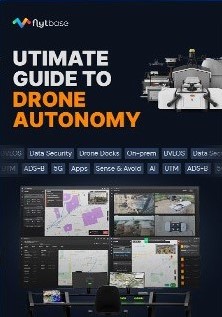Get Your Free Drone Autonomy Guide Today!

Drones are efficient and cost-effective in capturing visual data, on an object, or an earmarked piece of land. That is why they have proliferated into many industries, and unmanned aerial vehicles (UAVs) are now being used for a variety of monitoring purposes. Modern drones are highly capable of monitoring. Powered by intelligent software, drones can be flown over the internet, stream live videos, and cover long distances by leveraging fixed wings.
Using such capabilities, UAV service providers can thus deploy drones to monitor the assets of an airport and even long runways and transmit the live video footage to stakeholders sitting far away. Note: Learn how FlytBase powered the very first remote construction site inspection in the city of Lillestrøm, Norway over a 5G network.
Benefits of Using Drones for Airport Asset Monitoring
Drones are a better tool for monitoring than ground-based vehicles, because of the following reasons:
- Drones are small and agile vehicles that can go in nearly all places, especially those where it might be dangerous for humans to go.
- A single drone can cover a large area very easily and quickly.
- A drone can be fitted with a thermal camera, which might be used during the night time.
- Drones can be made smarter by fitting them with companion computers. For example, an operating system like FlytOS, when installed on a companion computer, provides AI-based features like precision landing, object detection, and collision avoidance.
- Drone-based monitoring can be automated with the help of cloud-connected platforms such as FlytBase.
How FlytBase Business Enabled Dr-ONE to Monitor One of DronePort's Airports
The infrastructure of an airport requires periodic monitoring for maintenance purposes. One of our partners, DR ONE is leveraging the FlytBase platform to deploy drones for runway, hanger, and airport vegetation monitoring. Compared to conventional methods, aerial monitoring has the following benefits:
- Minimum disruption to airport operations while monitoring since no land-based equipment is used.
- Data is collected by the drones which can be later processed using standardized software.
- Since a drone can carry a variety of sensors, there is richness in the data collected by the drones.
- The data produced by drones is traceable and reproducible which eliminates any form of subjectivity that an inspector might have.
By leveraging the capabilities of FlytBase, DR-ONE was able to perform the following activities during a monitoring-mission of one the runways of DronePort (EBR 62), Belgium:
- Using the advanced mission planning feature of FlytBase, they controlled the flight path of their drones over an area close to 88 hectares.
- The waypoints in FlytBase support the setting of altitude and speed which DR-ONE used to control the flight behavior of drones so they cause minimum disruption to airport operations. The precision settings of FlytBase allowed them to maintain an average speed of 17 km/h during their mission.
- The live video streaming capability of FlytBase enabled DR-ONE to monitor the runway, other infrastructures like airplane hangars, and the surrounding vegetation.
- FlytBase gave DR-ONE a unified dashboard to monitor the entire operation, including the ability to change views from map view to cockpit view.
- The geofence feature of FlytBase allowed DR-ONE to conduct safe operations by restricting the flight area of a drone since only a limited section of the airport had to be monitored. In addition to geofences, FlytBase’s built-in RTH (Return to Home) function allowed them to call their drone back to the base after completing the mission.
FlytBase Enterprise for Airport Monitoring
The enterprise version of FlytBase provides a whole host of customizations and features to adjust to situational challenges like operating in an airport. Some of them are as follows:
Integration

Airports operate under severe restrictions for the safety of aircraft and people on the ground. The airspace above and around airports is managed and controlled by the Air Traffic Control. So anyone flying a drone inside or close to an airport would require coordination with the Air Traffic Control.
There are service providers that provide intelligence on airspace and detailed map overlays of restricted airspace. FlytBase Enterprise provides REST API that can be used to integrate with such services, enabling service providers like DR ONE to conduct monitoring activities safely without violating any airspace norms.
Add-ons

Both the enterprise and business version support thermal cameras; coupled that with AI-add-ons, available in the enterprise version, like object detection, an operator can identify damages to the runway and other assets much more easily.
Fleet Management

One of the reasons why drones are useful is because they can cover a large area quickly. Managing multiple drones is the primary pain point that FlytBase solves. Both the enterprise and business version offers a unified dashboard to manage and control a fleet of drones. In monitoring missions, as the one DR-ONE did, multiple drones are beneficial since airports are spread across a large area.
Apart from Runway Pavement Monitoring What Other Places Drones can be Used?
Here are some of the use cases where drones are being adopted for aerial monitoring:

Drones are being used to monitor traffic: London Metropolitan Police are using drones to monitor traffic conditions. They are primarily using drones to pip-point drivers engaging in road-rage.
Crowd Monitoring: During the recent 2020 COVID pandemic, drones were used to monitor the streets of cities in India for catching unlawful gatherings during the lockdown phase. Learn how an Indian startup established India’s first drone command center using FlytBase.
Monitoring of Properties: Both commercial and residential real estates are using drones to safeguard their perimeters. A software solution like FlytBase can automate drone-patrolling around a property to protect its perimeter.
Wild-life monitoring: Drones are being used by forest officials around the world to keep an eye on forest life, and safeguarding it from dangers like poaching and illegal deforestation.
Summary
In this blog, we primarily discussed how DR ONE used the FlytBase platform for the monitoring of assets of an airport with great advantages. A fleet management system like FlytBase makes complex operations like monitoring less challenging and yields some of the following benefits:
- Time-saving: Since multiple drones can be deployed and managed easily.
- Cost-saving: A single operator can control and manage multiple drones from a unified dashboard.
- Compliant: Operating in an airport means coordination with multiple agencies; the integration features of FlytBase allows for that.
FlytBase is the perfect tool for drone service providers looking to upgrade their capabilities regarding monitoring either of airport assets or any other use case.

Baisali Ghosh

 English
English Spanish
Spanish

.webp)

.svg)
.webp)
%20(1).png)
